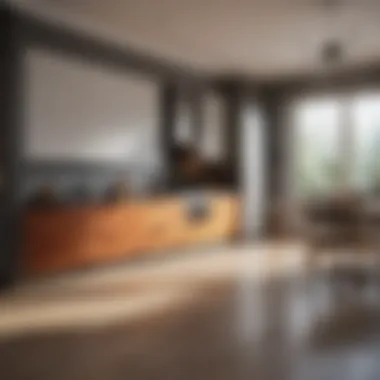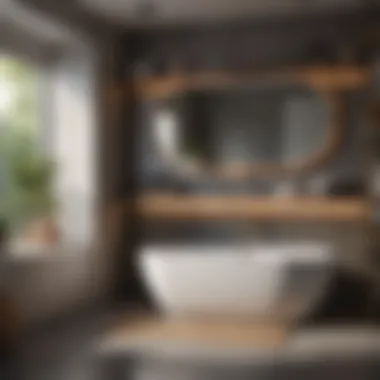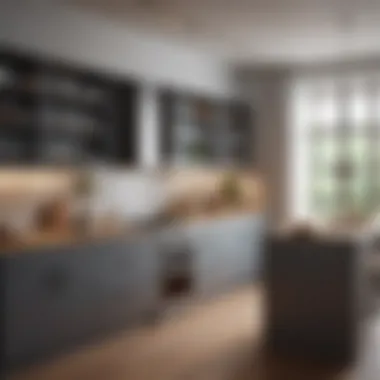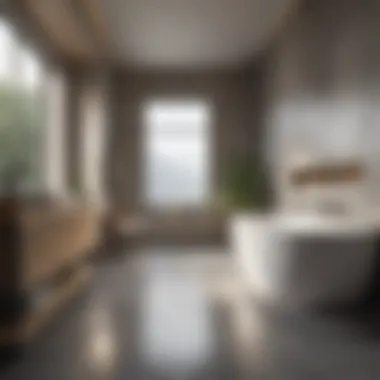Crafting Elegant Kitchens and Baths: A Design Guide


Materials:
When embarking on the journey of designing craft kitchens and baths, careful selection of materials is paramount. The choice of materials will influence not only the aesthetic appeal but also the functionality and durability of the space. Here is a detailed list of materials recommended for your DIY projects in kitchens and baths, along with their exact measurements.
List of Materials:
- Plywood (for cabinets):
- MDF (for panels):
- Countertops:
- Backsplash Tiles:
- Sink (kitchen or bath):
- Faucets:
- Cabinet Handles/Knobs:
- Paint (for walls and cabinets):
- Grout (for tiles):
- Sealant (for countertops):
- 3/4" thick, cut to your desired cabinet dimensions
- 1/2" thick, multiple sheets as per design specifics
- Granite or Quartz, typically 100" x 25"
- Ceramic or Glass tiles, approx. 12" x 12" sheets for ease of installation
- Standard size: 33" for kitchen; 24" for bath
- One per sink, select style that matches overall design
- 4-6 per cabinet, select design and finish that complements the area
- At least one gallon per area, use semi-gloss or satin finish for bathrooms and kitchens
- One box should cover up to 100 square feet
- Available in various quantities, use as per instructions on the package
DIY Steps:
Designing kitchens and bathrooms involves several clear steps. With a solid plan and the right materials, you can create stunning spaces. Here’s a step-by-step process to guide you:
Step 1: Planning
- Define your space layout. Measure dimensions carefully and create a rough sketch.
- Choose a style that suits your personality and home. Consider modern, traditional, or eclectic designs.
Step 2: Material Acquisition
- Purchase all materials, ensuring you have enough for the total area you will be working on, adding a small extra for mistakes.
Step 3: Construction
- Begin with the cabinetry. Use the plywood and MDF to construct the bases and frames.
- Install countertops, securing them with the appropriate sealant to prevent water damage.
- Lay down the backsplash tiles, applying grout as specified by product instructions.
Step 4: Installation of Fixtures
- Position the sink and secure it in place. Attach faucets according to the manufacturer's guidelines.
- Install cabinet handles and knobs meticulously to maintain uniformity.
Technical Aspects:
To successfully execute these DIY projects, the right tools and timing are crucial. Below are the tools required, along with some technical insights.
List of Tools:
- Drill: For making holes in wood and installing fixtures.
- Screwdriver Set: Essential for fitting handles and installing cabinets.
- Tile Cutter: Needed for resizing tiles for the backsplash.
- Measuring Tape: To ensure precise measurements throughout the project.
- Level: To check that surfaces are even.
- Caulking Gun: For applying sealant and ensuring water tightness.
Timing Specifics:
- Estimate around two weeks for most kitchen or bath remodels, depending on the complexity of design and size.
- Plan around 2-3 days for tile installation, allowing adequate time for grout to dry.
Critical Techniques:
- Always cut wood and tiles with sharp tools for clean edges.
- Sand down wood surfaces before painting to achieve the smoothest finish.
DIY Project Process:
Following these sequential steps ensures steady progress towards completion:
Installation Method:
- Start with cabinetry, then fit countertops with the designated sealant.
- Proceed to install the backsplash and any tiling.
- Finally, attach fixtures like the sink and faucets.
Troubleshooting Tips:
"If you encounter uneven surfaces, consider using shims to adjust and level cabinetry. This step is key for aesthetics and functionality."
- For misplaced tiles, carefully remove them while wet and reapply until proper alignment is achieved.
- In case of incorrect faucet installation, consult the manual for corrective steps before sealing.


This systems-oriented approach synthesizes both design and technical proficiency, essential for creating exceptional craft kitchens and baths.
Prolusion to Design Craft in Kitchen and Bath
Design craft in kitchen and bath is a critical focus area for homeowners and designers. These spaces reflect personal style and practicality, impacting daily routines and lifestyle. Understanding this craft ensures these areas are not only functional but also resonate with individual aesthetics.
Creating a well-designed kitchen and bath goes beyond mere appearance. It involves understanding user behavior, spatial arrangement, and the importance of materials. Thoughtful design enhances usability, making everyday tasks easier and more enjoyable. This section lays the groundwork for exploring the essential components that contribute to effective kitchen and bath design.
Defining Craftsmanship in Interior Design
Craftsmanship in interior design refers to the attention to detail and skill in creating functional yet beautiful spaces. It encompasses a range of practices, from selecting high-quality materials to executing intricate finishes. In the context of kitchens and baths, craftsmanship influences both durability and aesthetics.
When defining craftsmanship, it’s critical to recognize that it involves more than just the aesthetic appeal. It is the tangible result of skilled work combined with an understanding of how spaces work. Craftsmanship also reflects an appreciation for traditional methods as well as modern techniques. For instance, custom cabinetry in kitchen design showcases the culmination of planning, precision, and expertise.
It's about balance. A kitchen should not only be a hub for culinary tasks but also a space that is warm and inviting. In baths, the craftsmanship must blend tranquility with utility, enhancing the overall experience. Good craftsmanship results in designs that adapt to users' needs while maintaining high standards of quality and refinement.
The Importance of Kitchen and Bath Spaces
Kitchen and bath spaces hold significant importance in the home. They are often considered the heart and soul of a household. The kitchen is a gathering place, supporting nourishment and interaction among family members. It reflects the essence of daily life, where meals are prepared and shared.
The bath offers a personal sanctuary. It is a space for relaxation and rejuvenation. Both areas, therefore, demand heightened consideration. Their design directly influences not only functionality but also emotional well-being.
Investing in quality design for kitchens and baths can lead to enhanced property value. More importantly, it promotes an enjoyable living experience. Key aspects such as sufficient storage, appropriate lighting, and thoughtful layout in these spaces serve practical purposes while contributing to overall aesthetic harmony.
In summary, prioritizing craftsmanship and understanding the significance of kitchen and bath environments is essential. Those involved in their design have an opportunity to impact how these vital spaces serve the home's inhabitants, thereby enriching the overall quality of life.
Design Principles for Kitchen and Bath
Design principles are foundational to creating harmonious kitchen and bath spaces. These principles guide the way a space is organized, ensuring that it is both functional and visually appealing. Implementing thoughtful design elements can enhance daily living, making kitchens and baths not just areas for practical use, but also spaces that enrich the overall home experience.
Functional Layouts
Functional layouts refer to the arrangement of elements within a kitchen or bath that enhance usability. In a kitchen, the layout should facilitate efficient movement between the cooking, cleaning, and storage areas. The well-known work triangle—comprising the stove, sink, and refrigerator—serves as an essential guideline in this consideration. An effective kitchen layout ensures minimal traffic disruption and maximizes convenience during meal preparation.
In bathrooms, effective functional layouts prioritize access and comfort. Factors such as the placement of the toilet, shower, and sink can considerably affect usability. A well-designed bathroom layout allows multiple users to move around freely without collisions, thus preventing inconveniences during busy mornings.
Consider the following points when planning functional layouts:
- Space Measurements: Accurate measurements of the room are essential to accommodate appliances and fixtures comfortably.
- User Flow: Identify optimal pathways to facilitate seamless movement, reducing congestion during peak times.
- Zoning: Group together similar functions, like cooking and cleaning areas in kitchens and bathing and grooming areas in baths.
Balancing Aesthetics and Usability
Creating a balance between aesthetics and usability is crucial in kitchen and bath design. A space can look stunning but if it does not function well, the enjoyment is significantly diminished. Elements like cabinetry, counters, and fixtures must serve practical purposes while also embodying the desired style.
Aesthetic choices should correspond to functionality. For example, selecting surface materials that are both attractive and easy to clean can contribute to maintaining the beauty and hygiene of the space. The integration of textures, colors, and shapes should enhance the overall visual appeal without compromising usability.
Here are key considerations for balancing aesthetics and usability:
- Material Selection: Choose materials that suit both the functional needs and aesthetic desires. For example, quartz countertops combine durability with stylish appearances.
- Lighting: Proper lighting can accentuate design elements while ensuring visibility for tasks. Layered lighting solutions can create ambiance without sacrificing functionality.
- Color Schemes: Select colors that evoke a specific emotion while keeping in mind how they interact with natural light and space size.
"A well designed kitchen or bath speaks to the soul of the home, merging beauty with practicality to create a sanctuary of daily life."
Material Selection and Sustainability
Material selection is a pivotal aspect of designing kitchens and baths. The right materials enhance not just the aesthetics, but also the functionality and durability of these crucial spaces. In the context of sustainability, the choice of materials carries ethical implications and can significantly impact the environment. Understanding how to choose materials wisely can lead to spaces that are beautiful, practical, and environmentally responsible.
When considering material selection, several factors come into play. Aesthetics are vital; the materials should resonate with the overall design theme while providing long-lasting beauty. Durability is equally important; materials used in kitchens and baths are subject to daily wear and tear, so they must withstand moisture, stains, and heavy use. Furthermore, maintenance requirements of different materials need to be considered, as some may require more upkeep than others.
In addition to these practical concerns, there is a growing trend towards sustainability. Selecting materials that have a minimal environmental footprint contributes positively to the planet. This not only enhances the livability of homes but also aligns with a broader societal shift towards eco-consciousness.
Choosing the Right Materials
Choosing the appropriate materials for kitchen and bath design requires an understanding of both performance and appearance.
- Natural Stone: Options such as granite and marble offer durability and timeless visual appeal but may need sealing to protect against moisture.
- Solid Surface: This type of material offers versatility in color and shape and is non-porous, making it easy to clean and maintain. It is well-suited for contemporary designs.
- Wood: While wood brings warmth and character, it requires careful selection and treatment to prevent water damage. Choosing treated or reclaimed wood can enhance sustainability.
- Tile: Available in various materials like ceramic, porcelain, and glass, tiles are durable and easy to clean. Their visual diversity allows for creative design, with options for both modern and traditional aesthetics.
- Eco-Friendly Materials: Consider materials like bamboo or recycled glass, which are sustainable choices that also provide unique aesthetics.
In selecting your materials, thinking about the combination of these elements will help achieve a thoughtful design that meets practical needs while aligning with personal ideals around sustainability.
Sustainable Practices in Kitchen and Bath Design
Incorporating sustainability into kitchen and bath design goes beyond just material choice. There are several practices worth adopting:
- Energy-Efficient Appliances: Use products with Energy Star ratings to reduce energy consumption. This choice not only conserves resources but also saves money over time.
- Water Conservation: Install low-flow fixtures to reduce water usage without sacrificing performance. This step contributes to both environmental preservation and lower utility bills.
- Sourcing Locally: Whenever possible, choose materials that are locally sourced. This practice lessens transportation emissions, supports local economies, and may offer unique styles suited to your area.
- Proper Waste Management: During renovation or construction, recycling materials can reduce landfill waste. Organize a waste management strategy that includes sorting and disposing of materials responsibly.
- Timeless Design: Focus on creating a design that will remain appealing over time. Trends may fade, but classic styles endure and minimize the need for frequent renovations.
By integrating these sustainable practices into the design process, homeowners can create spaces that are not only functional but also reflect a commitment to environment and responsible living.
The Role of Technology in Modern Design


The integration of technology into kitchen and bath design is revolutionizing how these spaces function and feel. In today’s fast-paced environment, efficiency and convenience are paramount. Designers and homeowners now weigh the benefits of smart technology as a key element in their design strategy. This section examines specific advancements in technology, their benefits, and important considerations for implementing them.
Smart Solutions for Kitchens and Baths
Smart technology is increasingly common in kitchens and bathrooms, enhancing usability and functionality. Smart appliances like the Samsung Family Hub refrigerator or the Kohler Numi toilet exemplify how innovation elevates traditional elements. These devices not only do basic tasks more efficiently but also integrate with smartphones for remote access and monitoring.
Moreover, features like voice activation help to simplify daily moments. For example, you can use voice commands to adjust lighting, temperature, or even start cooking functions. This is particularly helpful for multitasking individuals or families who prioritize convenience.
- Benefits of Smart Solutions:
- Improved energy efficiency
- Enhanced safety features
- Greater control and convenience
- Customization for individual preferences
However, it remains essential to consider user-friendliness and durability. Technology should not complicate simple tasks; instead, it should enhance the overall experience. Ensuring a good balance between high-tech and user-friendly design is crucial.
Integrating Technology Seamlessly
When designing a kitchen or bath, integrating technology must feel natural, not forced. This requires thoughtful planning. For instance, placing charging stations for devices within cabinetry allows for visibility and accessibility while maintaining aesthetics.
Design Considerations:
- Wiring and Outlets: Ensure you plan for adequate number of outlets for devices and charging stations.
- Style Compatibility: Select smart devices that complement the overall design theme. For instance, a sleek, stainless steel appliance would work well with modern decor.
- User Education: Familiarize users with technology use. This minimizes frustration and enhances satisfaction.
Integrating technology should enhance functionality without sacrificing aesthetic quality.
This seamless integration can transform essential spaces into interactive environments where technology aligns harmoniously with everyday life. By doing so, homeowners can enjoy significant improvements in both the functional and emotional impact of their kitchens and baths.
Exploring Trends in Kitchen and Bath Design
Understanding current trends in kitchen and bath design is crucial for homeowners and designers alike. Trends not only reflect changing tastes but also respond to technological advancements and lifestyle shifts. Keeping abreast of these trends can lead to better investment decisions when renovating or designing spaces. Moreover, trends can enhance a home’s value and appeal, making spaces more functional and inviting.
Minimalism in Design
Minimalism emphasizes simplicity and functionality. In kitchen and bath spaces, this trend focuses on clean lines, open spaces, and a reduced color palette. The core idea is to create an environment that feels open and unrestricted, capitalizing on both visual and physical space.
- Benefits of Minimalism:
- Enhances clarity and reduces clutter.
- Promotes a serene environment.
- Easier maintenance and cleaning.
In kitchens, flat-front cabinets and integrated appliances exemplify minimalism. For baths, floating vanities and frameless glass showers add to the feel of openness. The use of neutral colors with occasional bold accessories can maintain visual interest without overwhelming the senses.
Bold Colors and Textures
On the opposite end, many modern kitchens and baths embrace bold colors and textures. This trend involves integrating striking hues or dramatic patterns that serve as focal points.
- Advantages of Bold Choices:
- Makes a powerful statement about personal style.
- Can brighten spaces and introduce energy.
- Personalized design that reflects homeowner's individuality.
In kitchens, vibrant backsplashes, such as emerald green tiles, can catch the eye. In bathrooms, textured wall panels or colorful fixtures add depth and character. Mixing materials, such as marble with matte black finishes, creates an engaging, visually compelling contrast.
"Choosing between calm minimalism and dynamic boldness in kitchen and bath design can profoundly influence the atmosphere of your home."
Emotional and Functional Impact
The emotional and functional aspects of kitchen and bath design hold significance that extends beyond mere aesthetics. These spaces form the backdrop of daily life, influencing not only how individuals interact with their homes but also impacting their well-being. Understanding the interplay between emotion and function is crucial for creating environments that both satisfy practical needs and evoke positive feelings.
Creating Inviting Spaces
An inviting space is one that offers warmth and comfort. Key elements in achieving this include appropriate lighting, color schemes, and furniture arrangements. For kitchens, consider integrating warm, soft lighting to create a welcoming atmosphere, especially during evening hours. In contrast, baths can benefit from a soothing ambiance, often enhanced by candlelight or dimmable fixtures.
Color choices play a fundamental role; neutral palettes can provide a sense of calm, while brighter hues can energize a kitchen, making it feel more lively. Textures, such as soft textiles or natural materials like wood and stone, add another layer of comfort, inviting one to linger longer in these spaces.
- Thoughtful Layout: Ensure that flow is optimized. An open layout in a kitchen facilitates communication, making meal prep a shared experience.
- Personal Touches: Incorporate personal artifacts or art. These items can spark joy and create emotional resonance.
- Greenery: Introducing plants can enhance both aesthetics and mood. Houseplants can purify the air and promote relaxation.
"An inviting kitchen or bath not only serves a functional purpose but also enriches the soul."
Functional Considerations for Different Lifestyles
Different lifestyles demand varied functional features in kitchen and bath designs. It is vital to assess how the space will be used daily. For instance, a family-oriented kitchen typically requires more storage and durable surfaces to withstand daily wear. In contrast, a modern kitchen for minimalists might focus on sleek counter space with hidden appliances and easy-to-clean surfaces.
- Cooking Habits: Consider whether the space will facilitate large meals or quick snacks. This affects appliance selection and counter space.
- Accessibility Needs: Designing for accessibility ensures that all users can navigate the space comfortably. This might involve lower countertops, wider paths, and easy-to-use fixtures.
- Personal Preferences: Some people might prioritize a spa-like bath experience, demanding features like a deep soaking tub or rainfall shower.
By framing design choices around individual needs and lifestyles, both emotional satisfaction and functionality can be achieved, ensuring that the kitchen and bath are not just practical buildings but spaces that genuinely feel like home.
Case Studies in Kitchen and Bath Design
Case studies in kitchen and bath design serve as an essential component of understanding successful outcomes in real-world applications. They provide invaluable insights into how theoretical principles are implemented in practice. These studies often showcase notable transformations, revealing the nuances that can make or break a design project. Analyzing case studies allows homeowners and designers to learn from previous successes and failures, paving the way for more informed decisions in their own projects.


There are specific elements that case studies highlight. They demonstrate the importance of:
- Functional layouts: How spatial arrangements create usability and enhance daily activities.
- Material choices: The impact of selecting sustainable and aesthetically pleasing materials that suit the homeowners’ needs.
- Design challenges: Various obstacles encountered during the project, and the creative solutions that emerged from them.
The benefits of studying these cases are numerous. They encourage adaptation to different lifestyles and needs, inspire innovative approaches, and foster a deeper appreciation of craftsmanship.
Moreover, they help in understanding the emotional resonance of spaces. Well-designed kitchens and baths not only fulfill their intended practical functions but also contribute to feelings of comfort and satisfaction for the user.
"Studying real-life design successes gives insight into blending creativity with practicality."
Successful Transformations
Successful transformations in kitchen and bath design often begin with a clear understanding of the homeowner’s needs and lifestyle. One illustrative case involved a family who wanted to combine traditional aesthetics with modern functionality.
The kitchen was initially cramped and outdated. By reconfiguring the layout, the designers created an open space that encourages interaction. Key features included:
- Island Installation: The addition of a large central island acts as both a cooking surface and a gathering place for family members.
- Smart Storage Solutions: Custom cabinetry optimized the available space, integrating pull-out pantries and hidden compartments.
For the bathroom, transforming a small area into a relaxing sanctuary was essential. Features such as a double vanity and beautiful fixtures were prioritized. The incorporation of:
- Natural Light: Expanding windows to allow more sunlight helped in creating an airy feel.
- Soaking Tub: The installation of a free-standing tub added a spa-like element into daily routines.
Ultimately, these transformations not only enhanced functionality but also increased property value, showcasing how thoughtful design can reap both immediate and long-term benefits.
Innovative Design Solutions
Innovative design solutions often arise when traditional ideas are reimagined in unique ways. A standout example is a minimalist kitchen that incorporates multifunctional elements. This space utilized:
- Integrated Technology: Smart appliances were seamlessly integrated into the cabinetry, optimizing space and elevating functionality.
- Modular Furniture: The use of modular components allowed the kitchen layout to be adaptable, accommodating various cooking and entertaining styles.
In bathrooms, innovative ideas can address common issues such as space constraints. A notable solution involved the introduction of a compact shower design combined with a bath. By using a clear glass barrier and lighter materials, the space felt bigger while still offering the luxury of both experiences.
Furthermore, some projects focus on sustainability. For instance, using reclaimed wood for cabinets not only adds character but also reduces the environmental footprint. The creativity displayed in sourcing these materials reflects a growing trend toward responsible design.
Future Directions for Kitchen and Bath Design
In the realm of interior design, particularly when it pertains to kitchens and baths, it is vital to consider the future directions shaping these spaces. As trends evolve, so do the expectations of homeowners and designers alike. Emerging technologies and shifting societal values play a significant role in the ongoing transformation of these fundamental areas in a home.
Anticipating future directions allows for the incorporation of innovative practices that prioritize not just aesthetics, but also functionality and sustainability. It fosters an environment where designs can adapt to changing needs, ensuring that these essential areas remain relevant and efficient for years to come.
Emerging Trends to Watch
Keeping a keen eye on emerging trends is essential for anyone involved in kitchen and bath design. Among the upcoming favorites, we see a strong inclination toward smart technology integration. Homeowners aspire to incorporate devices like smart faucets, refrigerators, and lighting systems that enhance convenience and resource efficiency. With the growing popularity of voice-activated and mobile applications, the ease of controlling various elements from anywhere in the home cannot be overstated.
Another trend gaining momentum is a push for sustainable and eco-friendly materials. Designers and homeowners alike are becoming more conscious of their environmental footprint. Utilizing recycled or sustainably sourced materials is no longer a niche preference. Instead, it is becoming an industry standard. Some specific materials include bamboo, reclaimed wood, and recycled glass, which not only reduce waste but also add a unique charm to spaces.
Here are some key trends to keep an eye on:
- Integration of smart home technologies.
- Use of sustainable and recycled materials.
- Open-concept layouts allowing seamless transitions throughout the home.
- Multi-functional spaces that combine different utilities without sacrificing style.
The Evolving Role of Designers
The role of designers in kitchen and bath spaces is shifting as well. No longer are they merely aesthetic evaluators; they are becoming strategic problem solvers. The complex interplay of technology, sustainability, and user needs drives designers to research and understand more about their client’s lifestyle demands.
Designers must now be well-versed in various aspects, from ergonomics to environmental impacts. Providing tailored solutions requires a deep comprehension of emerging products and trends in the industry. Moreover, effective communication is paramount. Designers must articulate their vision clearly and ensure clients understand the implications of their choices.
An evolved designer may focus on:
- Understanding the significance of space in daily life.
- Leveraging technology to create efficient designs.
- Emphasizing sustainability throughout the design process.
"A successful kitchen or bath design is not just about beauty, but crafting a space that meets the client's unique needs while considering the future."
By remaining adaptable and aware of these shifting dynamics, designers can better serve their clients and elevate the functionality and aesthetics of kitchens and baths for years to come. Engaging with the evolving landscape of design ensures that spaces are not just enjoyable today, but also resilient for the future.
Finale: Crafting the Ideal Kitchen and Bath
In an era where home spaces reflect personal values and lifestyles, crafting the ideal kitchen and bath is essential. These areas are more than functional zones; they are sanctuaries that enhance daily living. By synthesizing design concepts, ergonomic principles, and modern technologies, one can create environments that embody both style and practicality.
Recap of Key Design Elements
Understanding key design elements is vital for achieving a cohesive kitchen and bath. Some of these elements include:
- Layout: The arrangement must facilitate ease of movement and function. For kitchens, the classic work triangle enhances workflow between the sink, stove, and refrigerator. In baths, consider accessibility and comfort.
- Materials: Quality materials not only provide durability but also contribute to aesthetics. For instance, quartz countertops are a favorite for kitchens due to their resilience and elegance. In bathrooms, natural stone tiles create a sense of luxury.
- Lighting: Proper lighting solutions elevate the usability of any space. Soft, ambient lighting in bathrooms creates a calming atmosphere, while task lighting in kitchens ensures efficiency during meal preparation.
- Color Palette: Choosing the right colors can influence mood and perception. For example, light colors often make spaces appear larger, while darker tones can create a cozy feel.
By prioritizing these elements, homeowners can design spaces that perform well and make a statement about personal style.
The Lasting Impact of Thoughtful Design
Thoughtful design speaks volumes about the homeowner’s values and priorities. A well-crafted kitchen and bath not only serve practical purposes but also foster emotional connections. Spaces that are designed intentionally can:
- Enhance Daily Experience: Functionality and beauty coexist in well-planned spaces. A kitchen with efficient workflows allows for smoother cooking and gathering times.
- Increase Home Value: Buyers often look for modern, aesthetically pleasing kitchens and baths, which greatly influences resale value.
- Support Sustainability: With a focus on environmentally friendly materials and technologies, designs can reflect a commitment to sustainability, appealing to eco-conscious families.
"Thoughtful design transcends basic necessity, embedding meaning and intention within the walls of a home."







